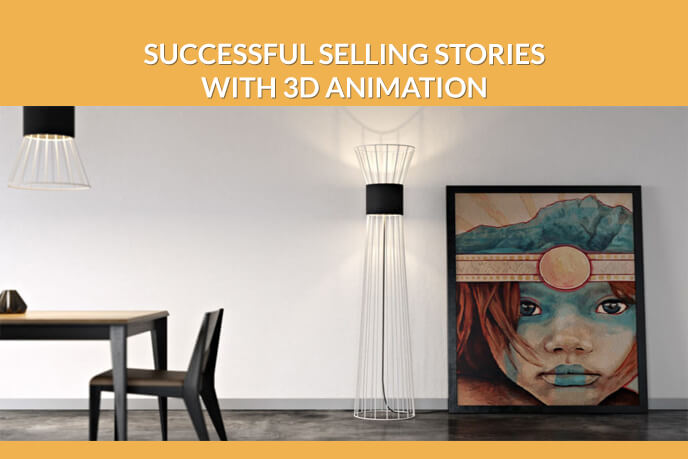3D MODELING AND ANIMATION FOR MARKETERS: HOW TO TURN AN IMAGE INTO A SUCCESSFUL SELLING STORY
3D modeling and animation are widely used in modern marketing. They offer not just a cheaper alternative to traditional means of product visualization, but expand the boundaries of what promotional materials can be. Customization on the fly, draggable and rotatable items on images, 360-degree views - these are just a few ways to make product presentation exciting. You have an arsenal worthy of respect - but how to use it properly?
Since late 80s-early 90s a new type of content marketing strategy was designed. In a nutshell, instead of selling the product, selling the idea of how useful said product is, how cool it would be to have it and so on. On top of that, visual storytelling techniques that were used since TV advertising era work today as well. If you manage to sell ideas while utilizing visual storytelling tropes and tricks coupled with use of animation and 3D modeling, you’ll have to increase production - whatever goods you’re selling will attract customers in droves. Learn how to boost sales and entice customers using 3D modeling and animation today!
#1. The Power Of 3D Animation For Advertising
Animation is a powerful tool in advertising, even if it’s as simple as a 360-degree view. 3D modeling produces objects as a whole with no blind spots, so an animator just needs to rotate an item and show the rotation frame by frame with 3D animation tools. But the effect is immense. First, moving pictures grab attention much easier than static ones - that’s common knowledge . Secondly, a 360-degree view shows the piece from every side, so that clients can personally make sure that the quality of goods is high and they look gorgeous from any angle. Animation can be used as an interactive medium too - with a bit of clever programming customers will be able to rotate the 3D models by themselves, zoom in and out and do whatever they would do to a real item. On top of that, 3D modeling and animation are instrumental for giving your goods a selling story - storytelling is always better in motion.
#2. Using Close-Ups For Showing Details
Details are crucial to visual storytelling. Material quality, signs of age and wear, tiny author additions that give items a unique look and feel - everything matters for visual storytelling. Artists tend to focus on the bigger picture, since 2D is limiting in terms of image resolution. Nobody wants to spend hours upon hours working on a 4K ad for a single marketing campaign! CGI, on the other hand, is much more flexible. 3D modeling and animation make a difference in terms of how good can an object look up close. With new types of 3D modeling like 3D sculpting adding miniscule details is much easier than with classic means, as such even Ultra HD 4K images can be zoomed in indefinitely without any loss in quality. Add the free camera with 3D animation and voila - the selling story is done!
#3. Storytelling With Organic Context
Context is another vital element of any successful promotional material. Decor and paraphernalia make images feel more alive and sell the idea of how perfectly they fit clients’ homes. 3D modeling and animation are perfect for creating vibrant environments that appeal to anyone. This task can be left to the 3D modeling studio you’re working with or you can hand-pick decor from catalogs and describe the kind of surrounding you want to place the product in. Either way, this visual storytelling technique works wonders in attracting customers.
#4. Personalizing The Experience With Customisation
Modern shoppers want unique experience, individual approach and customisable content. 3D modeling and animation are a cost-effective solution to that. Everything is digital, so things can be reshaped, “created” from different materials and placed in every context possible. And why stop at that: movable elements on the screen, disassemble/reassemble feature, showing stages of production in animated form - everything is possible with 3d animation advertising!
#5. Involve Both Customers And Employees
When marketing a product launch, it’s a good idea to involve potential customers as well as company’s employees in advertising. With 3D modeling and animation you can avoid using your staff or any real people - instead, ask to place people in context. 3D modeling studios not only have libraries of stock item models, but have human models as well. These can be used to sell the idea of actual people using your merchandise. And 3D animation models posing as your employees can be used to show service quality of your company.
#6. Work With Online Influencers
People tend to listen more to online influencers than to mass media personas. Working with popular bloggers can give you several advantages. First, the clicks, which are vital in ecommerce. Second, online influencers are perfect for commercial storytelling - let them say how good your product was for them. And third, with help of 3D modeling and animation you can create promotional materials for a unique line of merchandise with an Internet star’s “logo” on it - to attract their audience. A win-win situation for everyone.
If you want to succeed in ecommerce, 3D modeling and animation are your choice. They’re versatile and effective for promotional material creation, using many visual storytelling techniques to gain an advantage in competition. Start using CGI today with our 3D modeling services!



2 Comments on “3D MODELING AND ANIMATION FOR MARKETERS: HOW TO TURN AN IMAGE INTO A SUCCESSFUL SELLING STORY”
Thanks for sharing such an excellent post.
I’m looking forward for your next post!